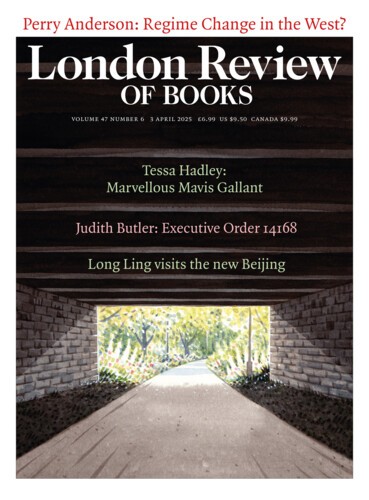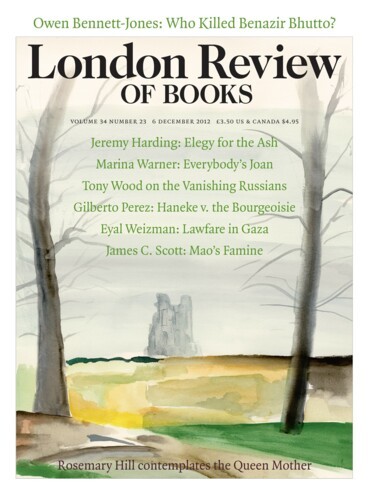Robert Frost’s crack about free verse – that it’s tennis without a net – might be modified to describe Georges Perec’s novels: they’re tennis with nets everywhere. His whodunnit La Disparition (1969), a lipogram, was written without the use of the letter e (it was translated into e-less English as A Void by Gilbert Adair in 1994).1W, ou le souvenir d’enfance (1975) finds in the letter of its title both a cipher for a missing child thought to have survived a shipwreck, and a vision of a rigidly ordered polis on an island off Tierra del Fuego inhabited, as Perec put it in a letter to Maurice Nadeau, ‘by a race of athletes wearing white tracksuits emblazoned with a big black W’. The 99 chapters of his last and longest novel, La Vie mode d’emploi (1978), were arrived at through three interlocking constraints: the planning of a narrative around a cross-section of a Parisian apartment building; the use of a bi-carré combinatoire to derive each chapter’s ‘schedule of obligations’ (setting, decor, age and sex of characters, distribution of incidents and objects, literary and historical allusions); and, so as not to leave the chapter sequence to chance, a polygraphie du cavalier, or ‘Knight’s Tour’ chess problem, which is the pattern a knight makes when travelling to every spot on the board without revisiting a single square twice (Perec tweaked the 8 x 8 layout of the chessboard to accommodate the 10 x 10 layout of the apartment block). Asked, in an interview with Claude Bonnefoy in 1977, why he resorted to such contortions for the making of fiction, Perec replied: ‘Je me donne des règles pour être totalement libre.’
La Disparition is probably the best known of the works associated with the group of writers and mathematicians comprising the Ouvroir de Littérature potentielle, or Oulipo. Founded by François Le Lionnais and Raymond Queneau, the group devoted itself to inventing, analysing and sometimes applying constraints for the making of literature. The idea arose in the autumn of 1960 at a colloquium on Queneau’s work at Cérisy-la-Salle, and the initial members met officially for the first time the following November under the name Séminaire de littérature expérimentale. A month later they changed the name to Oulipo, in part, they claimed, because the word séminaire smacked too much of artificial insemination and of the haras (stud farm), and in part because they liked the way ‘ouvroir’ suggests at once a workshop and a sewing circle. Precursors include the Collège de ’pataphysique (with which both Queneau and Le Lionnais had been associated) and the Bourbaki collective, a group of mathematicians who published their excursions in set theory under the pseudonym Nicolas Bourbaki. One group that was not a model was Surrealism. As Le Lionnais put it in an essay on Queneau, the constraint he insisted they agree on from the start was that there be no ‘fulminations, excommunications or any form of terror’, alluding to André Breton’s tyrannical control over the movement he founded, and of which Queneau had first-hand experience. Le Lionnais, for his part, also had first-hand experience with tyranny: he’d been active in the French Resistance and survived the prison camp at Dora.
Far from being a strident break with the past, Oulipian practice is preoccupied with tradition. What they call ‘anticipatory plagiarism’ can be found in everything from Lasus of Hermione, the sixth-century BC inventor of the lipogram (from the Greek leipo, ‘to leave out’); the love lyric manuals of the troubadours; the Ars Magna of Ramón Llull; the concentric permutations of the sestina; Poe’s tales and critical essays (‘The Purloined Letter’ finds Auguste Dupin going up against a villain who is ‘both poet and mathematician’); Lewis Carroll’s chessic fantasias; and Raymond Roussel, whom Queneau praised for ‘uniting the precision of the poet with the madness of the mathematician’. Perec in particular constantly invokes Herman Melville: W’s narrator identifies not with ‘Ahab’s boiling fury’ but with the sober and scrupulous Ishmael; the puzzle-making central figure in La Vie mode d’emploi is named ‘Bartlebooth’, splicing together Valery Larbaud’s A.O. Barnabooth and Bartleby, the wan copyist who one day prefers not to go on making duplicates of legal documents; in La Disparition Anton Voyl’s recovered diary contains a retelling of the plot of Moby-Dick (a lipogrammatically altered Ishmael appears as Ishmail). There’s also a clear line of influence on the mathematical side. Queneau’s ‘Les Fondements de la littérature d’après David Hilbert’ treats Hilbert’s claim that instead of points, lines and planes you might just as easily say ‘tables, chairs and beermugs’ as an invitation to make a further move to ‘words, sentences and paragraphs’. Given that aspects of the Hilbert scheme led Alan Turing to speculate about abstract machines that carry out programmed instructions, it is not surprising that Oulipo has links to computer science and AI research. Italo Calvino used an algorithm derived from a Greimas square for the composition of his recursive novel If on a Winter’s Night a Traveller; a ‘Mathews algorithm’, named for its inventor Harry Mathews, consists of generating content by moving sets of words, sentences or paragraphs through serial permutations (a technique he used to derive the Montagnard tribe’s dialect for his novel The Sinking of the Odradek Stadium); and Paul Braffort worked with the Atelier de Recherches et Techniques Avancées (ARTA) on computer stories that ‘read’ with you through a branching decision tree.2
The newest member of the Oulipo, Daniel Levin Becker, born in Chicago in 1984, opens his Many Subtle Channels: In Praise of Potential Literature with a description of a beau présent read at the funeral of François Caradec (an Oulipian and biographer of Roussel) at Montparnasse cemetery in 2008. A beau présent, or ‘beautiful inlaw’, is a version of the lipogram in which only the letters of the addressee’s name – in this case f, r, a, n, c, o, i, s, d, e – are used (in the inverse constraint, the ‘beautiful outlaw’, the letters of the person’s name are missing). Becker, an adroit renderer of constrained French into English, gives a version of one of the recited lines: ‘François caresses readers’ crania in a deep rose derision, in a fine ironic farce free of disdain.’ Another Oulipian trick, the S + 7, involves replacing every noun in a text with the seventh following it in a dictionary (the choice of dictionary of course plays a role here). Mathews, the only American Oulipian until Becker’s induction in 2009, put a few of these constraints to work in his 35 Variations on a Theme from Shakespeare. His lipogram in e for ‘To be or not to be, that is the question’ yields ‘Almost nothing, or nothing – but which?’; an S + 7 leads to ‘To beckon or not to beckon, that is the quinsy’; a ‘snowball with an irregularity’ gives ‘I am all mute after seeing Hamlet’s annoying emergency yourstruly Shakespeare’ (the ‘irregularity’ presumably being in the made-up word ‘yourstruly’, devised to preserve the structure of the snowball – i.e. each successive word a letter longer than its predecessor). Another of the more celebrated Oulipian works, Queneau’s Cent mille milliards de poèmes, is a set of ten sonnets with interchangeable lines, such that latent in the design are 1014 – or one hundred thousand billion – potential poems. Queneau said that if you read a sonnet every minute in eight-hour shifts every working day it would take a million centuries to finish the book. The original Gallimard edition isolates each line so that new poems are created by flipping the strips (the thorough and informative Oulipo Compendium unfortunately reprints Cent mille with perforated lines, in effect inviting you to cut up the book). And then there are works that have the feel of having been composed using constraints but haven’t been. This Paul Fournel calls the ‘Canada Dry’ effect: the ginger ale is bubbly but that doesn’t make it champagne.
Send Letters To:
The Editor
London Review of Books,
28 Little Russell Street
London, WC1A 2HN
letters@lrb.co.uk
Please include name, address, and a telephone number.



